Nature : Super “skin patch” sensor detects a variety of health data in real time
- Normal Liver Cells Found to Promote Cancer Metastasis to the Liver
- Nearly 80% Complete Remission: Breakthrough in ADC Anti-Tumor Treatment
- Vaccination Against Common Diseases May Prevent Dementia!
- New Alzheimer’s Disease (AD) Diagnosis and Staging Criteria
- Breakthrough in Alzheimer’s Disease: New Nasal Spray Halts Cognitive Decline by Targeting Toxic Protein
- Can the Tap Water at the Paris Olympics be Drunk Directly?
Nature : Super “skin patch” sensor detects a variety of health data in real time
Nature : Super “skin patch” sensor detects a variety of health data in real time. Super “skin patch” sensor comes out, which can simultaneously detect a variety of health data in real time.
The advent of this device represents the first step that scientists have taken towards multi-modal wearable sensors, through the fusion of acoustic and electrochemical sensors, for more comprehensive monitoring of human physiology and the realization of remote health transformation. The skin conformal sensor patch opens up a new path for the development of next-generation wearable devices.
In recent years, wearable sensors have been intertwined with concepts such as telemedicine, medical Internet of Things, and precision medicine. They can provide the function of actively and remotely monitoring physiological parameters, can continuously generate health data, and enhance the wearer’s self-monitoring compliance and care quality.
Using non-invasive wearable sensors to monitor a single physical parameter, there are already many product applications on the market, such as electrocardiogram, blood pressure (BP), and biochemical parameters, such as blood sugar, etc. At the same time, the industry is also exploring multi-sensor combinations, such as combining electrocardiogram electrodes with The combination of lactic acid or glucose sensors can monitor the athlete’s cardiovascular performance, metabolism, electrolyte balance or body temperature.
However, the use of integrated hybrid wearable sensors to conduct in-depth research on cardiovascular parameters, especially the correlation between blood pressure and biomarker levels, has not been further explored.
recently, Engineers from the University of California, San Diego have developed a soft, elastic skin patch that can be attached to the neck to continuously track blood pressure and heart rate while measuring the wearer’s glucose, lactic acid, alcohol or caffeine levels .
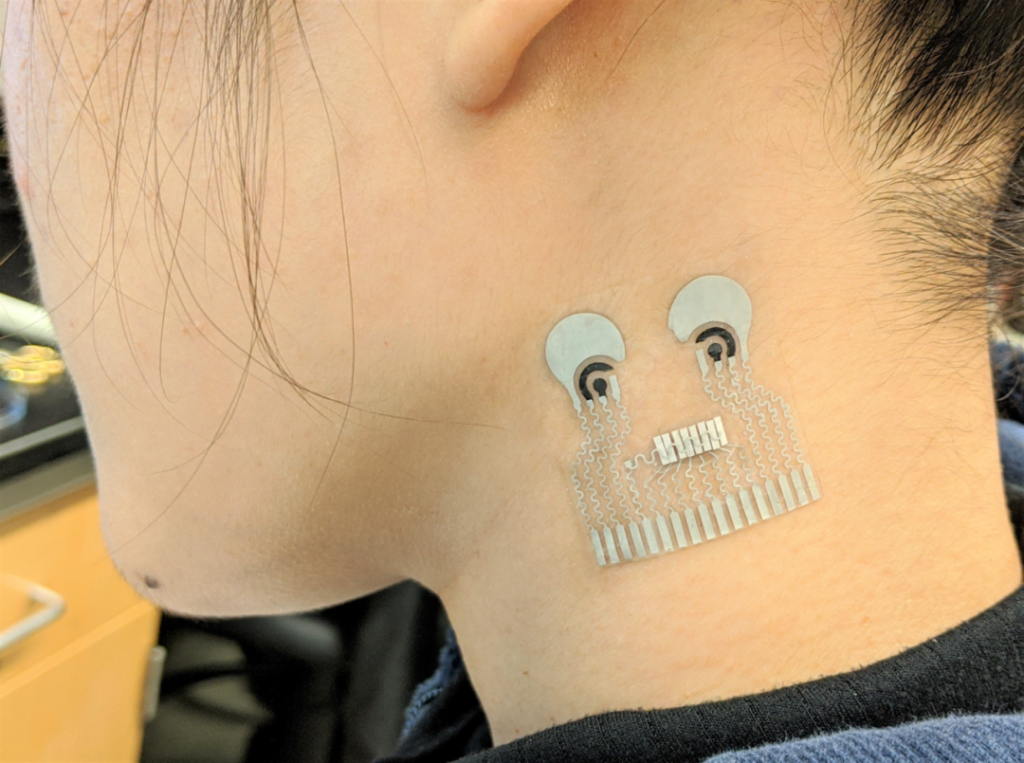
Figure|Putting the patch on the neck provides the best reading (Source: UC San Diego)
This is the first wearable device that can simultaneously monitor cardiovascular signals and multiple biochemical levels of the human body. The research results were published on “Nature Biomedical Engineering” on February 16. Wearable devices perform continuous and synchronized acoustic and electrochemical sensing, and people will have a richer understanding of the human body’s daily activities.
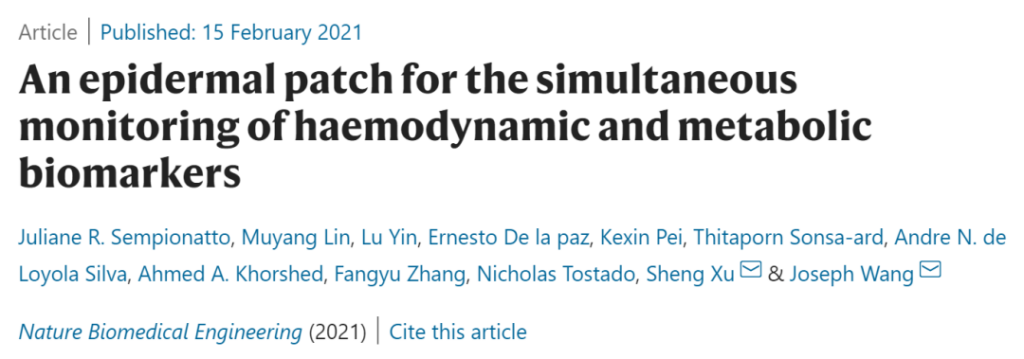
This magic patch will be very helpful for people with underlying diseases to monitor their health on a regular basis, and will also become a good tool for remote patient monitoring, especially during the COVID-19 pandemic, when people try to minimize In the case of visiting the clinic in person.
Joseph Wang, professor of nanoengineering at the University of California, San Diego and co-author of the study, said: “The novelty is that we used completely different sensors and combined them on a platform as small as a postage stamp. This wearable device A large amount of health information can be collected in a non-invasive manner without causing discomfort or interruption of daily activities.”
Market demand is outstanding
Heart rate (HR) and blood pressure (BP) are the two most important vital signs of the human body, which can dynamically and directly reflect the physiological state of the human body. These cardiovascular parameters may be affected by fluctuations in the concentration of various biomarkers, such as exercise, stress or the intake of food, beverages, and drugs. These activities may cause sudden and even fatal physical signs.
Therefore, the simultaneous application of blood pressure and chemical sensing may have clinical value, especially for people with potential health risks, such as the elderly, obese, or people affected by diabetes and cardiovascular disease, because they are affected by normal daily activities or diet. The physiological response is the most obvious.
Simultaneous monitoring of cardiovascular parameters and biomarker levels can also be of great help to the prevention, diagnosis and treatment of many diseases.
For example, acute and fatal septic shock, which usually includes a sudden drop in blood pressure accompanied by a rapid increase in blood lactate levels, and hypotension or high blood pressure caused by hypoglycemia or hyperglycemia, which can increase stroke, heart disease, retinopathy, and kidney disease in diabetic patients risks of.
Using a wearable device to track metabolites and hemodynamic parameters can improve the patient’s self-monitoring ability, because it simplifies the complex process of measuring these parameters with multiple devices, thereby indirectly preventing dangerous heart disease events and saving lives.
In addition, combining multiple sensing modes into a miniaturized skin-conforming wearable device also has additional advantages.
For example, critically ill and premature babies require continuous monitoring of various physical conditions, from hypoglycemia and sepsis-like infections to open-heart surgery, and continuous monitoring of blood pressure and lactate or glucose levels. The currently available neonatal monitoring systems require the application of multiple, usually invasive sensors on their tiny bodies, which involve inserting a catheter deep into the patient’s artery and constraining the patient to multiple hospital monitors. These sensors are unwieldy The devices are connected together, which is a painful way for parents and babies.
By integrating different sensing methods into a soft, skin-on patch, vulnerable patients from newborns to the elderly can be easily detected without any discomfort or pain.
Magic skin sensor patch
This novel sensor patch is an interdisciplinary product of two laboratories. It is a collaboration between the University of California San Diego Wearable Sensor Center and the laboratory of the University of California San Diego Nanoengineering Professor Xu Sheng.
Joseph Wang is also the head of the Nanoengineering Department and Wearable Sensor Center at the University of California, San Diego. He has been committed to developing new nano-bioelectronics and sensing technologies that can simultaneously monitor multiple signals in the human body-chemistry, physics, and electrophysiology. And Xu Sheng’s laboratory has been developing a soft and flexible electronic skin patch that can monitor blood pressure deep in the body.
Together, the researchers were able to create the first flexible, stretchable skin patch that combines chemical sensing (glucose, lactic acid, alcohol and caffeine) and blood pressure monitoring.
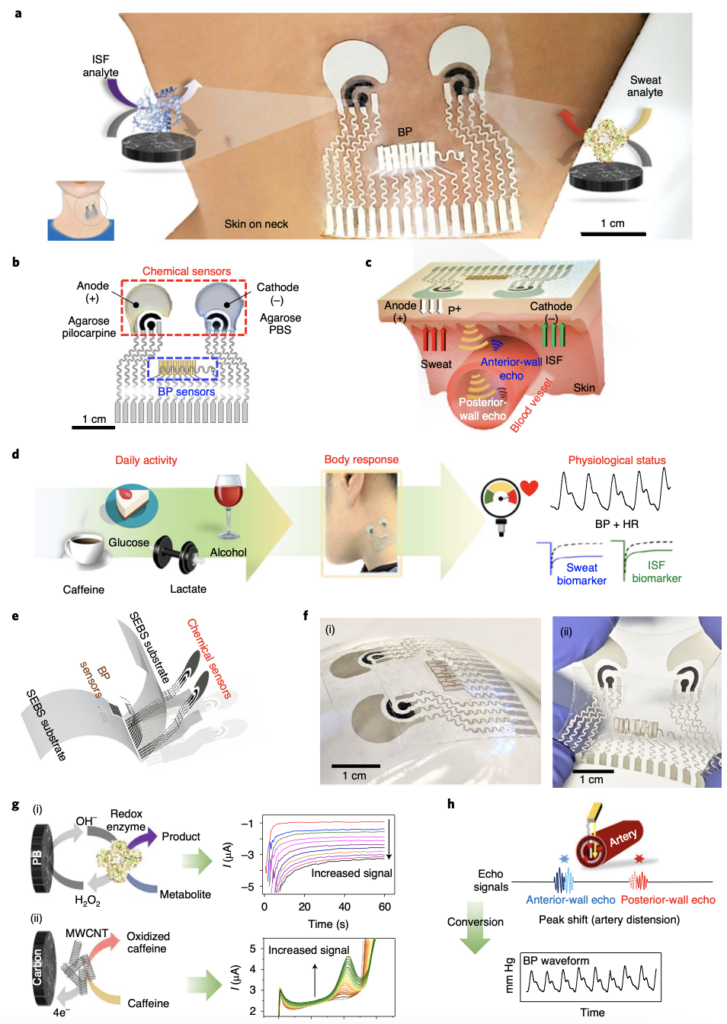
Figure|Design and mechanism of stretchable integrated BP-chemical sensor patch
The blood pressure sensor is located near the center of the patch. It consists of a set of small ultrasonic transducers, which are printed on the patch with conductive ink. The voltage applied to the transducer causes the transducer to send ultrasonic waves to the human body. When the ultrasonic waves bounce off the artery, the sensor detects the echo and converts the signal into a blood pressure reading.
The chemical sensor is composed of two electrodes, which are screen-printed on the patch by conductive ink. Electrodes that sense lactic acid, caffeine, and alcohol are printed on the right side of the patch; its working principle is to release a drug called pilocarpine into the skin to induce sweating and detect chemicals in the sweat. Another electrode that senses glucose is printed on the left. It works by passing a gentle current through the skin to release interstitial fluid and measure the glucose in the fluid.
In terms of engineering difficulty, the biggest challenge is to make a wearable conformal sensor with high mechanical elasticity and no sensor crosstalk.
Through strategic material selection, layout design and manufacturing engineering, the researchers integrated rigid and soft measurement components, namely customized piezoelectric lead zirconate titanate (PZT) ultrasonic transducers and printed polymer composites, and innovative solvent welding The process is finally processed. This design overcomes the engineering challenges associated with the integration of different sensing modes and materials to allow real-time monitoring of cardiovascular parameters and biomarker levels, and is related to the parallel sampling of interstitial fluid (ISF) and sweat biological fluids.
First, eliminate the mutual interference between sensor signals. Researchers must find the best distance between the blood pressure sensor and the chemical sensor.
Because the signal generation of acoustic sensors relies on high-voltage and high-frequency pulses, these pulses may cause signal drift in chemical sensors, and IP extraction, potentiostatic sensing, and potential scanning sensing may also cause noise in acoustic signals. In the end, they found that the one-centimeter spacing kept the device as small as possible while reducing interference.
Researchers must also figure out how to physically shield the chemical sensor and blood pressure sensor from crosstalk. The latter are usually equipped with liquid ultrasound gel to produce clear readings. But the chemical sensor is also equipped with its own hydrogel. The problem is that if any liquid gel flows out of the blood pressure sensor and comes into contact with other gels, it will cause interference between the sensors.
Here, the researchers prevented signal crosstalk between acoustic and electrochemical sensors by separating the two components spatially and using solid-state ultrasound and sensing hydrogel layers. They used a solid ultrasonic gel, and they found this This kind of gel is as effective as liquid gel, but it does not leak.

Figure|Sensor can stretch effect
Second, get the mechanical properties. In daily life, when the skin patch is expected to be stretched and deformed, mechanical stability is another key factor that determines the reliability of the skin patch sensor.
The impedance of the chemical sensor and the contact resistance of the PZT ultrasonic sensor may change with the strain force applied to the patch, which leads to changes in the measurement signal and affects the accuracy of the measurement results of the device.
Researchers have developed a solvent brazing process based on the rapid dissolution of SEBS-based materials and solidification at room temperature to achieve the stability of PZT contacts under mechanical stress. During the assembly process, the PZT sensor can be quickly installed and bonded to the SEBS substrate, and connected to the SEBS-based stretchable ink by wetting the electrode surface with toluene. Compared with the previous report, the assembly efficiency has been improved to a certain extent. .
The device also showed good mechanical elasticity after being transferred to the human body. During the 20% active tensile deformation, a mechanical rebound test was also carried out, in which the electrochemical sensor was stretched in two directions (horizontal and vertical). The evaluation is performed outside the body, and the blood pressure device is evaluated when the blood pressure signal is captured when the neck is turned 90° to the side.
During or after 100 stretching cycles, there is no change in the data waveform. The results show that the printed composite material is not affected by mechanical deformation. The piezoelectric transducer is aligned with the carotid artery when applied to the neck to obtain the best ultrasound signal .
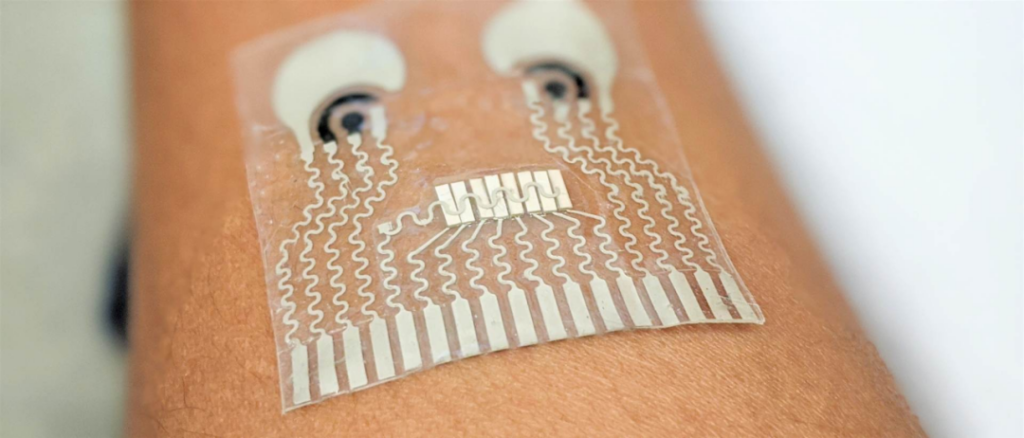
Figure|All-in-one patch with blood pressure and biochemical component monitoring function (Source: UC San Diego)
How effective is the measurement?
Through the monitoring of dynamic cardiovascular parameters and biomarker concentrations by this device, it is possible to evaluate the impact of daily activities on the physiological state of an individual, and continuously collect data on the user’s response to these daily activities.
The levels of lactic acid, glucose, alcohol, and caffeine in the human body fluctuate due to daily activities. In addition, the effects of these levels on blood pressure also vary depending on the individual’s physical condition.
For example, during prolonged exercise, due to metabolic stress, the lactic acid level in blood and sweat will increase, and the heart rate will increase to meet the oxygen demand of the muscles. The increase in blood pressure is due to the increased availability of vasodilators such as nitric oxide.
To study these effects, several volunteers were asked to bike for 30 minutes on a fixed level and then rest for 5 minutes. Record blood pressure to measure lactic acid when sweating is stimulated before and after exercise, and use commercial cuff blood pressure monitor and blood lactic acid meter to verify the obtained blood pressure and lactic acid level data. The blood pressure and sweat lactic acid data collected from the device are combined with other mature verification methods and The test results of commercial equipment are consistent.
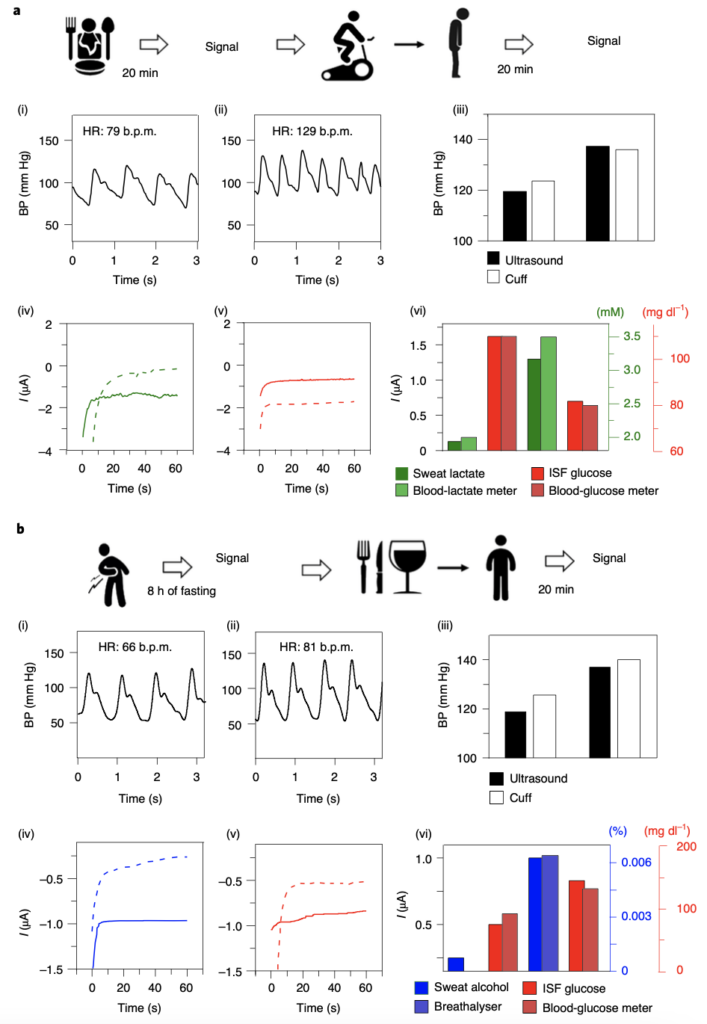
Figure|Body health parameter detection effect under different conditions
As another common unhealthy stimulus, excessive alcohol intake has been shown to increase cardiovascular risk through alcohol-induced hypotension and high blood pressure.
Through this patch sensor, it is found that for people who drink a lot of alcohol, there may be a considerable spike in blood pressure in the morning, which will greatly increase the risk of stroke. Non-heavy drinkers ingest a single alcoholic beverage can cause a temporary increase in blood pressure At the same time, the sensor allows reliable detection of alcohol in sweat, because this small polar molecule can be found in sweat.
Then, the researchers also evaluated the performance of the patch in real life scenarios. People usually experience a variety of activities, which may have a synergistic or offset effect on the body’s physiological response. A common example of counteracting blood sugar levels is exercise and food intake, because glucose can be quickly consumed during exercise to produce energy. As previous single stimulation tests have shown, exercise also increases an individual’s blood pressure and lactate levels.
The results show that the patch sensor can capture the complex physiological changes caused by simultaneous food and exercise stimulation, including digesting food to produce glucose as an energy storage device, glycolysis reaction consumes glucose and oxygen to release energy, blood pressure and heart rate The increase makes up for the lack of oxygen consumption and lactic acid production during hypoxic exercise.
This complex dynamic process requires continuous operation of the hybrid sensor to capture real-time fluctuations during the entire activity. The long-term monitoring of dynamic biomarkers and blood pressure fluctuations in physical activity by the sensor has also been confirmed.
What’s next?
In the paper, this multi-modal wearable technology was shown to help link daily activities (such as exercise, drinking, and eating) to changes in blood pressure, heart rate, and biomarker levels.
The experimental results support the possibility of developing a hybrid wearable sensor on a single conformal wearable patch. The sensor has a complex integration of chemical and physical sensors and can be used to simultaneously monitor multiple related parameters. Only by choosing materials wisely, optimizing structural engineering and considering high-throughput manufacturing processes can reliable and comprehensive skin sensor integration be achieved.
Although the integrated device shows attractive features, there are still many opportunities for improvement in the measurement of blood pressure, heart rate and metabolites. For example, the integrated patch relies on pilocarpine to stimulate sweat; extensive verification of a large number of individuals with different health conditions, including patients with diabetes and cardiovascular disease; through the development of electronic equipment with integrated ultrasound and multiple potentiostatic functions, as well as signal processing and The wireless transmission function makes the equipment completely miniaturized.
The researchers said that in the future, they will also work on the development of an independent acoustic sensor interface circuit, coupled with artificial intelligence-assisted signal processing, will completely transform the existing equipment into a comprehensive skin sensing system, so that the device can understand The health and physiological status of individuals in the prevention and management of chronic diseases.
The advent of this device represents the first step that scientists have taken towards multi-modal wearable sensors, through the fusion of acoustic and electrochemical sensors, for more comprehensive monitoring of human physiology and the realization of remote health transformation. The skin conformal sensor patch opens up a new path for the development of next-generation wearable devices.
Nature : Super “skin patch” sensor detects a variety of health data in real time
Nature : Super “skin patch” sensor detects a variety of health data in real time
(source:internet, reference only)
Disclaimer of medicaltrend.org



